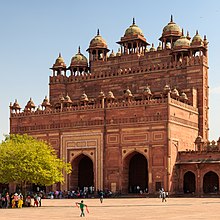User:Sattvic7/architecture of uttar pradesh
| This is a Wikipedia user page. This is not an encyclopedia article or the talk page for an encyclopedia article. If you find this page on any site other than Wikipedia, you are viewing a mirror site. Be aware that the page may be outdated and that the user in whose space this page is located may have no personal affiliation with any site other than Wikipedia. The original page is located at https://en.wikipedia.org/wiki/User:Sattvic7/architecture_of_uttar_pradesh. |
The architecture of Uttar Pradesh demonstrates a diverse and electic combination of Buddhist, Hindu, Indo-Islamic and Indo-European architectural styles. Two of its architectural monuments—the Taj Mahal, the Agra Fort as well as the township of Fatehpur Sikri founded by the famous Mughal Emperor Akbar are designated UNESCO World Heritage Sites. The architectural structures in Uttar Pradesh include Buddhist Stupas and Viharas, ancient monasteries, townships, forts, palaces, temples, mosques, mausoleums, memorials and other community structures.
Ancient Period[edit]
Under the Mahajanapadas[edit]
Uttar Pradesh was home to seven out of sixteen mahajanapadas of ancient India. Some forts from the kingdoms of Panchala (present-day Ahichchhatra near Bareilly) and Vatsa (present-day Kausambi, near Prayagraj) have been discovered.

Ahichattra [[1]]
Gupta architecture [3] [www.gktoday.in/gk/gupta-architecture-salient-features-and-examples]
Maurya architecture [m.jagranjosh.com/general-knowledge/amp/mauryan-empire-art-and-architecture-1490249718-1] https://www.drishtiias.com/to-the-points/paper1/mauryan-art-and-architecture-part-1
Under Mauryan rule[edit]
The structures largely consists of mound like structures calleds stupas containing relics (such as śarīra – typically the remains of Buddhist monks or nuns) that is used as a place of meditation. A related architectural term is a chaitya, which is a prayer hall or temple containing a stupa. While a few of these stupas have survived, a majority of them have fallen to ravages of time as well as the attacks of foreign invaders. The stupas in Piprahwa, Kushinagar, Shravasti, Kausambi and Sarnath are associated with the different stages of life of the founder of Buddhism—Gautama Buddha. The surviving Dhamek Stupa of Sarnath is an impressive 128 feet high and 93 feet in diameter. Among the ruins at Sarnath, structures of great significance, such as the famous Ashokan lion capital dated to around 250 BCE, originally surmounted on the Ashoka Pillar erected here, were found. The Lion Capital of Sarnath has been adopted as the National Emblem of India.
Classical Period[edit]
Famous temples are the Dashavatara Temple in Deograh, Kashi Vishwanath Temple in Varanasi and Krishnajanmabhoomi in Mathura.
Indo-Islamic[edit]

Sultanates[edit]
Atala Masjid of Jaunpur shows a lot of influences of Hindu architecture. In fact, there is a clear resemblance of Hindu style of architecture, in the entire Masjid. The reason for such similarity is because the Atala Masjid is situated on the site of a temple of Atala Devi.[1] Hence the Atala Masjid, Jaunpur also gets its name from this Hindu Temple.
Mughal[edit]

Uttar Pradesh has three World Heritage Sites: Taj Mahal, Agra Fort and the nearby Fatehpur Sikri. Allahabad Fort stands on the banks of the Yamuna near the confluence with the river Ganges. It is the largest fort built by Akbar.[2][3][4]
Taj Mahal[edit]
The Taj Mahal in Agra, built between 1632 and 1643 during the reign of Mughal Emperor Shah Jahan is considered to be one of the best examples of Mughal architecture, as well as Indo-Islamic architecture as a whole.[2][5] While earlier Mughal buildings were primarily constructed of red sandstone, Shah Jahan promoted the use of white marble inlaid with semi-precious stones. Buildings under his patronage reached new levels of refinement. It is surrounded by vast gardens on all four sides.
Oudh[edit]
Lucknow, the capital of the state, has several beautiful historical monuments such as Bara Imambara and Chhota Imambara.[6][7] It has also preserved the damaged complex of the Oudh-period British Resident's quarters, which are being restored.

British Colonial period[edit]
European styles[edit]
The Allahabad Public Library built in the Scottish Baronial style, and All Saints Cathedral, Allahabad and Kanpur Memorial Church built in the gothic revival style are examples of European-styled buildings in Uttar Pradesh.
Indo-Saracenic Architecture[edit]
The Lucknow Charbagh railway station and Kanpur Central railway station were built in the Indo-Saracenic style.

Post-Independence[edit]
NOIDA is a planned city and IT hub.[citation needed]
Notable buildings[edit]
-
Mulagandhakuti Vihara, Buddhist temple at Sarnath
-
Temple of the Tibetan community in Sarnath
-
Sridigamber Jain temple, Singhpuri, Sarnath, just behind the Dhamekh Stupa
References[edit]
- ^ Advanced history of medieval India By S.R. Bakshi
- ^ a b Centre, UNESCO World Heritage. "Taj Mahal". UNESCO World Heritage Centre. Retrieved 2018-12-23.
- ^ Centre, UNESCO World Heritage. "Agra Fort". UNESCO World Heritage Centre. Retrieved 2018-12-23.
- ^ Centre, UNESCO World Heritage. "Fatehpur Sikri". UNESCO World Heritage Centre. Retrieved 2018-12-23.
- ^ "Taj Mahal - Official Website of Taj Mahal, Government of Uttar Pradesh (India)". www.tajmahal.gov.in. Retrieved 2019-01-04.
- ^ "List of Monuments - Uttar Pradesh". Archaeological Survey of India. 8 July 2012.
- ^ "The historical monument called Bara Imambara of Lucknow that is also known as Asfi Imambara". Lucknow online news. Retrieved 8 July 2012.











